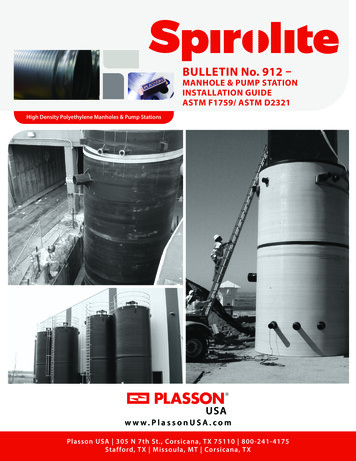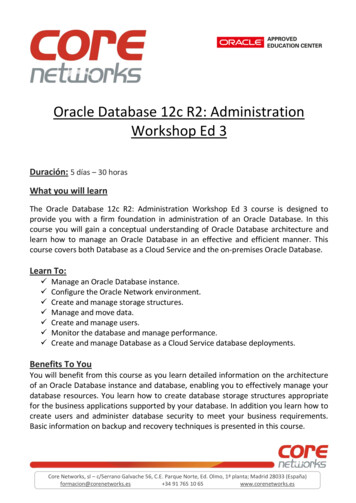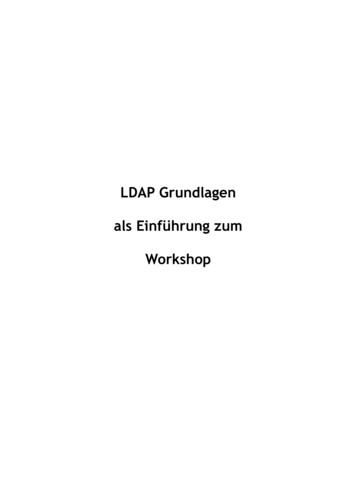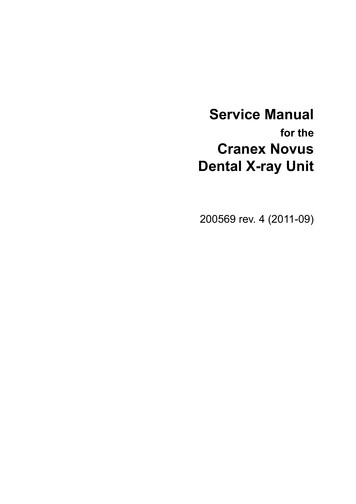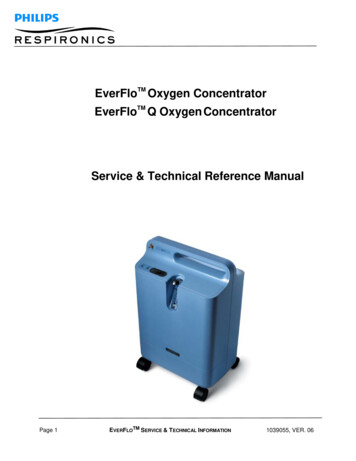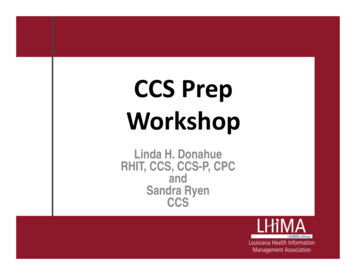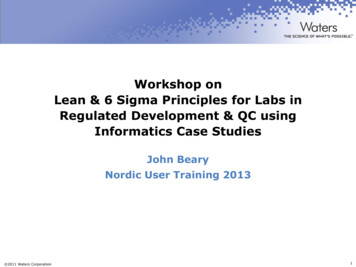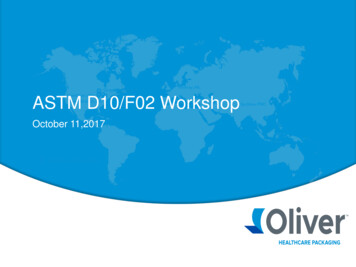
Transcription
ASTM D10/F02 WorkshopOctober 11,201710/26/2017Confidential 2017 Oliver1
Busting 1.0 lb. min. Peel StrengthGeoff PaveyTechnology Manager-Technical Fellow22
INTRODUCTION Challenges in the early 90’s with 1.0 lb. minimum forpouches “How do you validate to a 1.0 lb. minimum using 90 unsupported peel test method for uncoated pouches?” The answers were that you can’t, unless you use the 180 supported test method. Over 25 years, people are still asking the same questions.What should my minimum value be, and how do I meet the1.0 lb. seal strength “Standard” ? 1.0 lb. minimum for all packages and applications doesn’tmake sense.3
OUTLINEValue of seal strengthIntegrity requirementSeal strength vs. integritySeal strength referencesLiteratureRegulatoryWhere does 1.0 lb. minimum come from?A different approach for determining minimum strengthASTM-WK576564
Bottom line in Medical Device Packaging Maintenance of package integrity throughsterilization and distribution to the point of use isthe bottom line in Terminally Sterilized MedicalDevice Packaging. Package integrity simply means no holes inmaterials and no channels in seals.5
Seal Strength vs. IntegrityCommon seal integrity tests: ASTM F1929 Standard Test Method for Detecting Seal Leaks inPorous Medical Packaging by Dye Penetration ASTM F3039 Standard Test Method for Detecting Leaks inNonporous Packaging or Flexible Barrier Materials by DyePenetration ASTM F2096 Standard Test Method for Detecting Gross Leaks inPackaging by Internal Pressurization (Bubble Test)Common seal strength tests: ASTM F88 Standard Test Method for Seal Strength of FlexibleBarrier Materials ASTM F1140 Standard Test Methods for Internal PressurizationFailure Resistance of Unrestrained Packages6
Seal Strength vs. IntegrityASTM F2097 - Standard Guide for Design and Evaluation ofPrimary Flexible Packaging for Medical ProductsISO 11607-1 Annex B - Standardized test methods andprocedures that may be used to demonstrate compliancewith the requirements of this part of ISO 11607 Seal strength and burst testing are not classified asintegrity tests.7 Integrity tests determine if a package has pathways that couldallow for microbial penetration into the package. Holes and channels are not typically detected during strengthtesting unless are grossly significant in size.
Importance of Seal Strength1) Seal survival to the point of use 2)8Withstand real world stresses of sterilization, distributionand product load on package sealsProcess checks to ensure that sealing conditions arecontinually meeting expectations for above
Value of Seal StrengthEthylene OxideAutoclaveReal world stresses of sterilization on package seals9
Value of Seal StrengthStresses from distribution effects on package seals10
Value of Seal StrengthStresses from distribution effects on package seals11
Value of Seal StrengthProduct load on package seals12
Value of Seal StrengthProcess checks for maintenance of strength13
Hot Tack/Strength-PoorFailure Mode – Hot Tack14
Hot Tack/ Strength-Good15
Value of Seal StrengthForce to open a package for the end user16
Value of Seal StrengthEase of opening for the user17
Peel Strength in Medical Packaging LiteratureMedical Device Packaging Handbook. (1990).Chapter 3:Packaging Materials-Seal Strength:"In actual practice, peel angles will vary considerably fromtest conditions and, in fact, will change continuously as apackage is opened. Therefore, the measurement of peelvalues at a specified angle should only be used to establishstandards and measure reproducibility of a material.““A rule of thumb for comparing peelable packaging is that a180 peel may have a value as much as twice that of a 90 peel for the same adhesive seal and materials.”O'Brien, J. D. (1990). Medical device packaging handbook. New York: M. Dekker.18
Peel angle changes with opening19
PouchesSeal Strength Values90 180 Tail/sealTail/seal20Lids/Trays
Seal Strength ValuesASTM F88 demonstrates that peel strength valueschange with technique.21
Seal Strength ValuesLower values /variabilityHigher values /variability90 180 Tail/sealTail/sealHigher 1.022Lowest 0.7Highest 1.8-2.0
Peel Video 123
Peel Strength in Medical Packaging LiteratureThe Wiley Encyclopedia of Packaging Technology (1986).Healthcare Packaging-Opening:“The industry would like theseals to be strong enough towithstand the usual sterilizationand handling rigors and yetweak enough to open easilywithout material failure.”“This normally means a sealstrength of 0.75—2.64 lbf/in.(0.13—0.46 N/mm).”24“Many health-care packages are opened understress conditions requiring rapid access to theitem packaged. Most items require sterilepresentation. The opening mechanism must besuch as to facilitate both of these functions.Easy opening is best attained with peelable seals(see Fig.5). What constitutes “easy” is ill-defined.The industry would like the seals to be strongenough to withstand the usual sterilization andhandling rigors and yet weak enough to openeasily without material failure. This normallymeans a seal strength of 0.75—2.64 lbf/in. (0.13—0.46 N/mm). Both the device and the packagingmaterials must be considered in selecting the sealstrength range. If the weight and shape of thedevice tend to exert more pressure on the seals,the minimum allowable seal strength must beadjusted upward (30). Conversely, for weakerpackaging materials, one must lower themaximum allowable seal strength. To improve thepeel, packages are often designed with chevron orcorner starts to further promote quick opening.”Bakker, M., & Eckroth, D. (1986). The Wileyencyclopedia of packaging technology. New York: J.Wiley.
Peel Strength in Medical Packaging LiteratureThe Wiley Encyclopedia of Packaging Technology (1986).Healthcare Packaging-Opening:“Both the device and thepackaging materials must beconsidered in selecting the sealstrength ”“If the weight and shape of thedevice tend to exert morepressure on the seals, theminimum allowable sealstrength must be adjusted ”25“Many health-care packages are opened under stressconditions requiring rapid access to the itempackaged. Most items require sterile presentation.The opening mechanism must be such as to facilitateboth of these functions.Easy opening is best attained with peelable seals (seeFig.5). What constitutes “easy” is ill-defined. Theindustry would like the seals to be strong enough towithstand the usual sterilization and handling rigorsand yet weak enough to open easily without materialfailure. This normally means a seal strength of 0.75—2.64 lbf/in. (0.13—0.46 N/mm). Both the device andthe packaging materials must be considered inselecting the seal-strength range. If the weight andshape of the device tend to exert more pressure onthe seals, the minimum allowable seal strength mustbe adjusted upward (30). Conversely, for weakerpackaging materials, one must lower the maximumallowable seal strength. To improve the peel, packagesare often designed with chevron or corner starts tofurther promote quick opening.”Bakker, M., & Eckroth, D. (1986). The Wileyencyclopedia of packaging technology. New York: J.Wiley.
Effects of Product Weight on Seal Strength 1.0 lb.26 1.0 lb.
Peel Strength in Medical Packaging LiteratureMedical Device Packaging Handbook. (1990). Chapter 3:PackagingMaterials-Seal Strength:“Typical peelability range of various substrates, with adhesive, shown in Table 6.”Table 6 Peel ValuesSubstratePeel value(lb lin.)Surgical kraft (nonreinforced)0.5— 1.2Latex-reinforced kraft1—2Tyvek2—3Extensible films1—2Nonextensible films2—3Foil /paper laminations1—3Foil/film laminations2—4O'Brien, J. D. (1990). Medical device packaging handbook. New York: M. Dekker.27
Medical Packaging RegulationEN ISO 11607-1: 2006 Packaging for terminally sterilized medicaldevices - Part 1: Requirements for materials, sterile barrier systemsand packaging systems28 5.1.8 c) Materials shall demonstrate minimum specified sealstrength when a seal is formed with another specified materialunder specified conditions. 5.1.9 b) If formed by sealing, the specified requirements for sealwidth and seal strength (tensile and/or burst) shall be met.
Medical Packaging RegulationEN868-5:2009 Sealable pouches and reels of porous materialsand plastic film construction - Requirements and test methods 4.5.1 When tested in accordance with the method described in AnnexD the strength of the seal joint shall be not less than required for theintended purpose, both before and after being subjected to thesterilization process. Minimum value for seal strength in (healthcare facility) shall be 1,5 Nper 15 mm for steam sterilization processes and 1,2 N per 15 mm forother sterilization processes.1.5N/ 15mm 0.57 lb/in. (Steam )1.2N/ 15mm 0.46 lb/in. (all other sterilization ) 29NOTE 2: For applications outside healthcare facilities requirements aregiven in EN ISO 11607.
Medical Packaging RegulationEN868-7:2009 Adhesive coated paper for the manufacture ofsealable packs for medical use for sterilization by ethylene oxide orirradiation - Requirements and test methods: Clause 4.3.191.2N/ 15mm 0.46 lb/in.EN868-10:2009 Adhesive coated nonwoven materials ofpolyolefines for use in the manufacture of sealable pouches, reelsand lids - Requirements and test methods:Clause 4.3.10 0.08kN/m 0.45 lb/in.All state: “Report whether the tail was supported or unsupported”30
RegulatorySeal Strength Values Summary ISO 11607 – no minimum value specified EN 868–5 (1.5N/ 15mm) 0.57 lb/in. & (1.2N/ 15mm) 0.46 lb/in. EN868-7(1.2N/ 15mm) 0.46 lb/in. EN868-10 (0.08kN/m) 0.45 lb/in.Literature PKG Ency. - (0.13 N/mm) 0.75lbf/in. MED DEV PKG HDBK- 0.5lbs/in. (paper substrate)Experience Minimum values vary 0.3., 0.5 , 0.6 ,0.7 – 1.0, 1.2 , 3.0 lbs. depending onmaterials and application.Most important: What does your package need tosurvive until point of use?31
Rules of Thumb“A rule of thumb is a homemade recipe formaking a guess.”“It is an easy-to-remember guide that fallssomewhere between a mathematical formulaand a shot in the dark.”Parker, Tom. Rules of Thumb. Boston: Houghton Mifflin, 1983. Print.32
Rules of ThumbBlasting a Tree Stump :“You can blow most stumps out of the ground if you useone stick of dynamite for every 4 inches of stump diameter”Technical Projects Rule of Two:“Complex projects always take twice as long to finish asyour most thorough and conservative estimate, even whenyou used this rule and doubled your first estimate.”Parker, Tom. Rules of Thumb. Boston: Houghton Mifflin, 1983. Print.33
Stories:Stories Where 1.0 lb Originated Guaranteed Minimum from Material suppliers Material suppliers – delamination strength ofpaper (average peel strength ) TAPPI- (The Pulp and Paper Industry) committeeeasy open packaging LinkedIn stories34
Stories Where 1.0 lb OriginatedArticle –”Exposing the Myths of Tensile Seal Strength Testing”:“The one-pound-per-inch peak"requirement" came mostlyfrom material suppliers ofunconverted and convertedproducts.”“surgical-grade paper was king,seal-strength values weregoverned more by the internalbond strength of the paper”35“The one-pound-per-inch peak"requirement" came mostly from materialsuppliers of unconverted and convertedproducts. This was the best value theycould guarantee to medical devicecustomers. Back in the 1960s, whensurgical-grade paper was king, sealstrength values were governed more bythe internal bond strength of the paperthan by adhesive technologies. At thattime, device manufacturers were equallyconcerned about clean peels, the openingof the package without generating loosefiber and encapsulating the device. Thesolution, though expensive at the time,was to provide a heat-activated coatingon the paper.”Barcan, Donald S. "Exposing the Myths ofTensile Seal Strength Testing."Pharmaceutical & Medical PackagingNews 28 Apr. 2004: 1. Print.
Stories Where 1.0 lb OriginatedMaterial Suppliers : Delamination strength of paper Average peel strength of 1.0 lbs. Fiber tearing can start to occur at strengths greaterthan 1.0 lb. Carl Marotta Historical Healthpack comment: “ It seemed like a goodidea at the time.” Search for article he wrote.36
Stories Where 1.0 lb OriginatedTAPPI Committee: Two independent sources. 1.0 lb. was born out of a TAPPI committee looking ateasy opening packaging. A seal strength of 1.0 lb. was easy opening andpassed distribution challenges. Whether it was for rigid or flexible packaging or both,unknown. Contacted TAPPI, unable to verify story.37
LinkedIn Comments Earlier this year, reached out to LinkedInaudiences searching for the origin of 1.0 lb. Several interesting comments. Here are some snapshots from the stories .38
LinkedIn Comments Stories/ highlights: “1# is what "felt" good - not too strong to make it difficult, nottoo weak to make it feel insufficiently sealed.” “it got grandfathered from paper peel strength specification.” “I heard from some old timers that this is exactly where it camefrom.the paper industry and the limited capability of higherseal strengths due to tearing.” “I think the 1 lb standard came about from the force necessaryto cause paper to fracture resulting in non sterilecontamination (fibers).” “The 1 lb. spec was recommended and used by the paperindustry which then got "automatically transferred" to Tyvekseals. “ “In the famous words of industry pioneer Carl Marotta, fromthe early days of HealthPack."It seemed like a good idea atthe time“”39
LinkedIn Comments From LinkedIn comments there seems to besome common denominators: Material, Converters, and Carl Marotta.40
1.0 LB. ORIGIN STILL A MYSTERY?41
ASTM- WK57656 Item Standard Guide for determining minimum seal strengthfor Medical Device Sterile Barrier Packaging Systems– Scope: This guide provides information to clarify the process ofestablishing minimum peel strength f
ASTM F88 demonstrates that peel strength values change with technique. 22 Seal Strength Values Tail/seal . Tail/seal . 90 180 Lower values / variability . Higher values / variability . Lowest 0.7 . Higher 1.0 . Highest 1.8-2.0 . 23 Peel Video 1 . 24 Peel Strength in Medical Packaging Literature “The industry would like the seals to be strong enough to withstand the usual sterilization .


